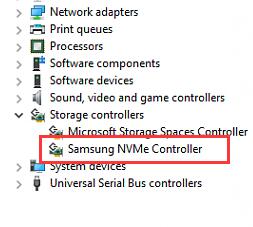
- #Uninstall samsung nvme controller driver install
- #Uninstall samsung nvme controller driver drivers
- #Uninstall samsung nvme controller driver driver
- #Uninstall samsung nvme controller driver windows 10
Thanks, I think I followed about 10% of what you said.
#Uninstall samsung nvme controller driver driver
I haven't heard back from Samsung yet - but I'm assuming that it's not an issue for their future product line - so there's no need for them to Sign the driver for what they would now consider a Legacy device for their NVMe Range. (I'll link you to the posts with my Bench)
#Uninstall samsung nvme controller driver install
(not really I did it just before - but I had to preload and install the IaStorAC.inf, before loading the IaAHCIC.inf in the Windows PE, OS and Recovery) - but I didn't bother with recovering data from the original RAID 0, and just chose to wipe. I would recommend doing a Hardware Raid, if users are going to use a RAID set up - but it would only be worth while - doing so at a New Install - trying to do this conversion on an Installed Online OS, is impossible - well. The drives I had was the stock HGST 1TB 7kRPM - and they have a 60% increase in performance. I had some spare time, so I wiped the default Windows AHCI RAID disks I had, and set them up in Bios as RAID, and I have it working while Samsung Magician is installed.

The AHCI on the HM87 is categorised as IDE/SATA ACHI Controller, and the RAID is SCSI SATA RAID Controller. This is why you can't switch out in BIOS between AHCI or RAID once Windows is Installed. This is where the problem can manifest - where Windows will set a different affinity for one of the drives - and then you'll encounter a BSOD or something The IRQ for the NVME and the SATA in AHCI/RAID should occupy the highest portion of the Negative IRQ (Closest to Zero) Starting at -2. I had the invalid signature when I purged my windows driver store - some people may experience other faults, or not at all. If you have the 1.4.7 (1.1) driver still in the WinSxS directory - Windows will fall back to that during one of those 3 stages. On the newer 960, the controller changed from on board, to another chip - i can't remember what it's called - but it changed where/how Windows sees the drive and it's controller - so the 960s will be OK - but for the older people using the 950 - if Windows tries to load the 2.2 driver - it may cause the Invalid signature. There's 3 stages where the driver can get injected - Windows PE (straight after POST/BIOS), then Windows itself, then in Recovery (Winre.wim in Hidden Partition C:\Recovery) If you can read the NVME in BIOS, it won't need the Signing like on the G751, because AMI/Aptio will have signed it for you - (as a result of adding it for native support). That site also provides Samsung magician and SSD firmware updates.ĭo you think there was a delay in signing the driver or something else? The url where I got the Samsung NVMe driver vers 2.2 is as follows:
#Uninstall samsung nvme controller driver drivers
I had read it is good to install Windows with secure boot disabled, then let Windows update the signature database depending on what drivers it detects, then re-enable secure boot. Maybe Samsung has now signed version 2.2 and Windows placed the signature into the secure boot signature database, which is stored on the BIOS chip I believe. from Samsung website, and after re-enabling Secure Boot, it is booting fine with no signature violation. Then I replaced the Windows provided "Standard NVMe Express Controller" with the Samsung NVMe controller version 2.
#Uninstall samsung nvme controller driver windows 10
On my new R5E build, I am booting Windows 10 Pro (Creator's Edition) 圆4 off the Samsung 960 Pro (M.2 slot), and did this install with Secure Boot disabled. Thread in Hardware section for mod/admins If you're not having issues - don't worry about this - but if you have experienced problems using a NVMe Storage device, this may be one of the factors attributing to the fault. I haven't been able to get this driver working properly in the PE while Secure Boot is enabled in my G751 Recovery Tinker Project. I was going to do it myself - but it needs Samsung's certificate, not mine. I'm going to be sending Samsung an email too - to see if they can get the driver signed. This driver can be loaded multiple ways - Windows will use it's own NVME driver until the Operating System is online, then load the Samsung Driver - however if Windows has installed it in such a way where the notebook attempts to load the driver during POST or prior to Windows Operating System - the device may fail to boot. Hi, I'm posting this here just for a heads up for some people - who may or may not experience problems with Samsung drives on the ASUS Notebook range.Įrrors should only start to manifest if the device is attempting to use secure boot with the current NVMe 2.2 driver from Samsung. Samsung's Site has hit the limit for SSD Downloads, so here:

They are still 2.2, but actually signed now

Samsung released WHQL Signed NVMe Drivers a few hours ago.


 0 kommentar(er)
0 kommentar(er)
